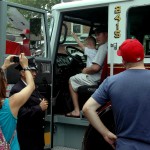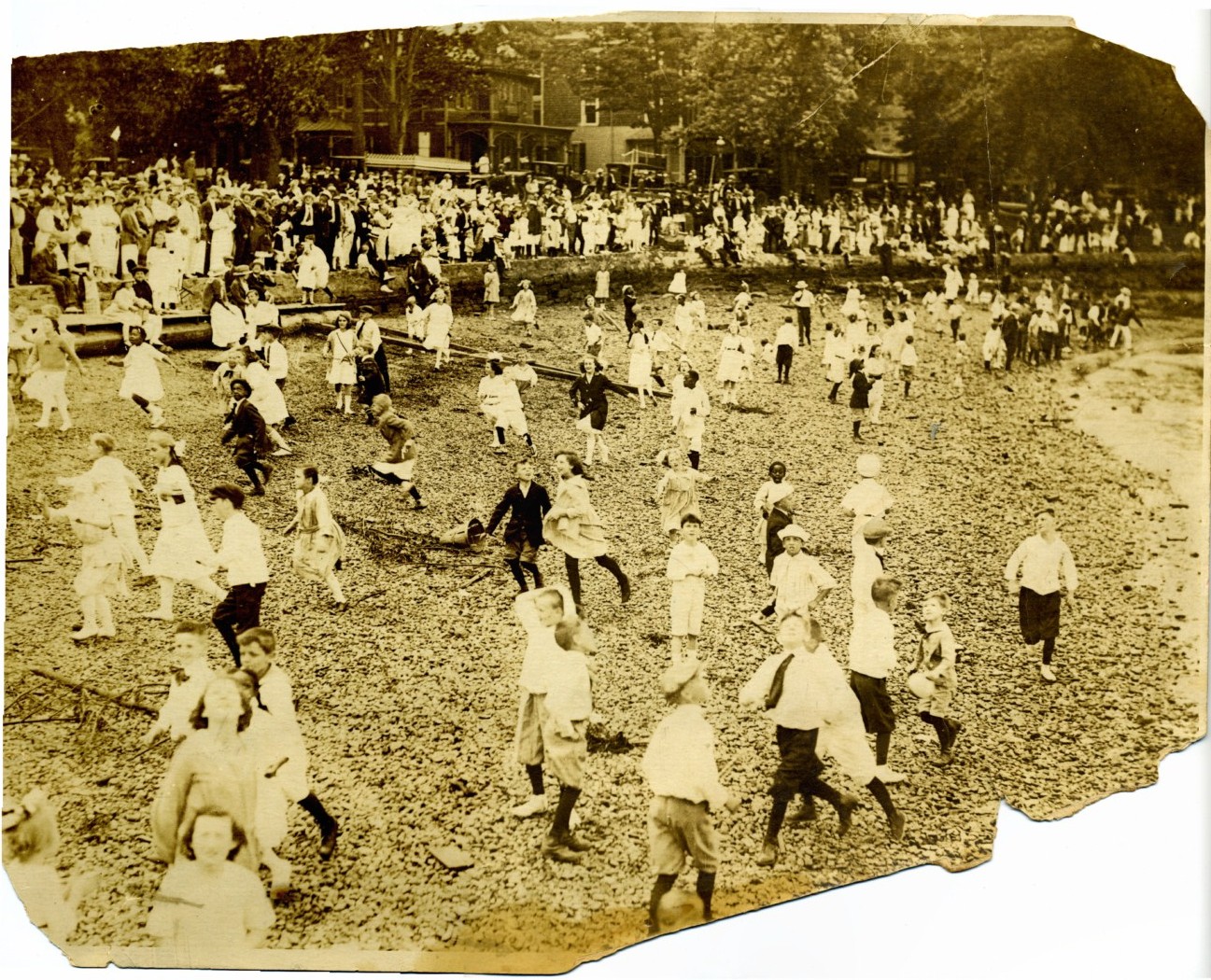
The July 4th post, How did Riverton’s “Glorious Fourth” start? referred to a number of July Fourth traditions which Mrs. Betty B. Hahle explained in her classic series of “Yesterday” columns published over her four decades of research and writing for the Historical Society of Riverton. I omitted her explanation of one longstanding parade tradition—the Mayor’s walking staff— until I could make certain of its status. As any observant parade spectator has noticed throughout the years, the Mayor always holds a long cane ringed with dozens of silver-colored bands as he or she walks.
Consider the above photograph of current Mayor Robert Martin with said walking staff.
To further explain the origin of this tradition, read below the complete text of our recently passed Town Historian’s “Yesterday” column from the September 1997 issue of Gaslight News entitled, “A Cane’s Name.”
A Cane’s Name
History is not static, as some might think. A different interpretation or the discovery of new materials can change a historical concept at any time. And slightly different accounts of an event provoke questions of which is accurate; age, perspective, and re-telling all influence the development of a legend.
In 1965 Riverton Yacht Club published a Centennial Booklet that contained two pages of memoirs of Ogden Mattis, an active member for many years. He also supplied a photograph of an early 4th of July Parade that was published with the caption “the Marshall’s baton is a Calcutta Cane brought from India by Og Mattis’ grandfather.”
The grandfather referred to was Louis Corner, who had come to Riverton from England circa 1863, and lived on Main Street.
Recently Sally Jane Mattis shared with me something her husband, George, had written in the late 1930s, when he was a student at Palmyra High School. A requirement of Miss Edna Ziegler’s Senior English class was the student’s autobiography. In his, George had written that his great-grandfather, Louis Corner, born in England…“traveled abroad many times visiting his parents and foreign countries.
On one visit to Switzerland in 1897 he brought back two Alpine Sticks and presented them to the town for the purpose of recording year by year the number of children in the annual parade on 4th of July… by placing silver bands on them…”.
We know that various kinds of walking sticks were popular in the late 19th century, and both records agree on who brought back the cane (s) that are a part of Riverton’s traditional 4th of July Parade. At first, the Marshall carried the cane, but for many years now it is the Mayor who carries it. A silver band bearing the year, mayor’s name, and the number of children participating that year is added to the cane after the event. In 1952 the last band that would fit on the original cane was placed on it, and 1953 started a new cane. Since 1958 the bands are of stainless steel instead of silver.
Another Corner legend about the 4th of July Parade is that Louis Corner’s young nephew, George, led the first Parade, in 1897. The Mt. Holly Herald carried a detailed account of the 1898 Parade, which said that it “was led by two 3-year-olds, George Corner, dressed as Uncle Sam, and Clarice Frishmuth, dressed as the Goddess of Liberty.” They were followed by ten little boys in Dewey suits (for the recent Dewey victory) and then by 250 children parading. (Gaslight News 1986, vol. 12 #4, told that story) There was no mention of a Marshall or of his baton. Would it have been called a Calcutta Cane or an Alpine Stick, if it had been described that day? – BBH
As the above photo of Mayor Martin shows, the tradition persists of adding a band to the cane each year engraved with the number of children in the parade. According to Phyllis Goffredo Rodgers, the official kid-counter for the past several years, the number this year was 185, about a half of last year’s showing and a fraction of the 600 tallied in 1908.

![post WW1 parade4 [2381x1905]](https://rivertonhistory.com/wp-content/uploads/2011/07/post-WW1-parade4-2381x1905-300x240.jpg)
Scouring my hard drive for other references to that July 4th airplane drop of paper tokens good for penny candy resulted in the above scanned image of a stereograph from the collection of Mrs. Elsie Waters with the caption, “Frank Mills’ Plane, 1923” and a scan of an undated photo from the collection of recently elected HSR Board Director Mr. Ed Gilmore. Elsie told me that it was Frank Mills who gave airplane rides for a fee, but I’ll have to confirm with her (or another reader) if he is the one who dropped the penny candy vouchers and if it was done for more than just the year 1921. Regular readers may recall that Mrs. Hahle reported on such a paper shield penny voucher plane drop for the year 1920. So far I have been unable to account for the difference in dates. Further, can any aircraft expert determine if the plane in Elsie’s stereograph and Ed’s photo are the same?

Segue to this 7.28MB PDF file of a 1920 Fourth of July Celebration Program that almost got away. The original once belonged to Mrs. Mary Jane Mento, widow of Mr. Danny Mento, a popular local musician. When she passed away, her daughter living in the South inherited it, and she placed it on an eBay auction. Gerald Blaney, a recent homeowner transplant from Palmyra to Riverton and very keen on local history, prevailed as high bidder and has generously allowed the use of the image seen here. Would that all such great finds be shared with the community by such altruistic persons.
![Riverton Fire Department 1925[1024x541]](https://rivertonhistory.com/wp-content/uploads/2011/07/Riverton-Fire-Department-19251024x541-150x150.png)

Classic cars and fire engines are always a part of the parade. Here’s an old one from 1925, again from Elsie’s stereograph collection, and a recent 2011 pic of Riverton Fireman Charles Dorworth with his daughter Nicole taking advantage of a photo op with her husband and son in the driver’s seat of Riverton’s 2005 Pierce 100 foot ladder apparatus, or “fire truck” to us civilians. The RFD, established 1890, is a respected institution with its own historic past which you can visit at this website link.
![post WW1 parade1 [2402x1922]](https://rivertonhistory.com/wp-content/uploads/2011/07/post-WW1-parade1-2402x1922-150x150.jpg)
Readers, please leave a comment, criticism, or even a correction, lest how else am I to get the record set straight? “Like” us on Facebook and tell your friends and family, whether local or across the miles, about the rivertonhistory.com website. With increasing visitor counts and membership support comes a greater chance to “connect the dots” and make sense of the separate pieces of our individual collections of artifacts, collectibles, and ephemera. – John McCormick, Gaslight News editor

![post WW1 parade2 [2376x1901]](https://rivertonhistory.com/wp-content/uploads/2011/07/post-WW1-parade2-2376x1901-150x150.jpg)
![New Leaf ready for the 4th [1600x1064]](https://rivertonhistory.com/wp-content/uploads/2011/07/New-Leaf-ready-for-the-4th-1600x1064-300x199.jpg)


![Roberts_Store [1521x1200]](https://rivertonhistory.com/wp-content/uploads/2011/07/Roberts_Store-1521x1200-300x236.jpg)
![The Grove, Palmyra, NJ 1938 [800x600]](https://rivertonhistory.com/wp-content/uploads/2011/07/The-Grove-Palmyra-NJ-1938-800x600-300x189.jpg)
![WWI signet ring top [768x768]](https://rivertonhistory.com/wp-content/uploads/2011/07/WWI-signet-ring-top-768x768-150x150.jpg)




















